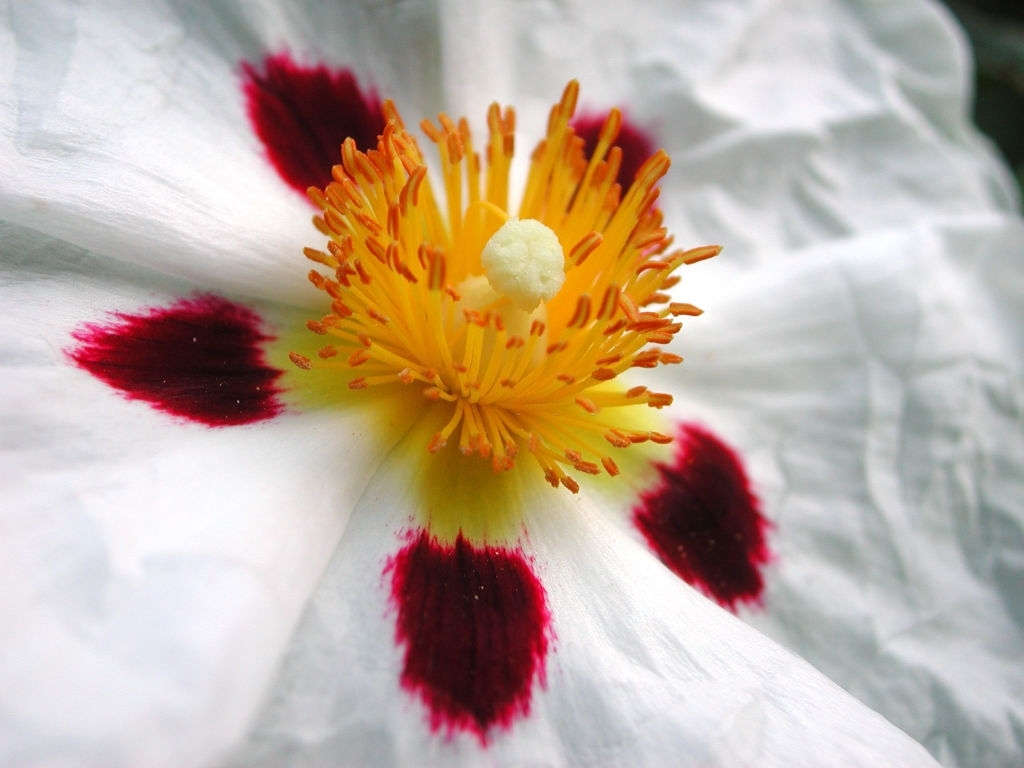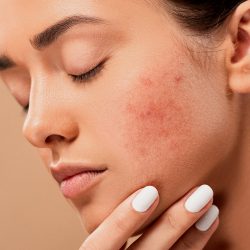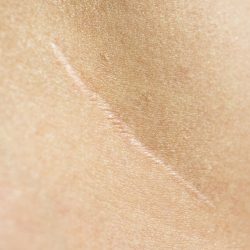Cistus has been used in medicine, cosmetics and aromatherapy for centuries for the quality of its gum. 25 centuries ago, Theophrastus referred to this plant by the Greek word kistos, which simply means capsule. The scent is reminiscent of ambergris. While the resins and essences they release protect the leaves from drought, the plant is said to catch fire if the temperature rises above 32 degrees.
Latin name:
- Cistus ladaniferus L.
Botanical family:
- Cistaceae
Producing organ:
- Leafy shoots
A little history
In ancient times, Crete was an exporter of labdanum, which was a veritable godsend at the time. Cretan labdanum (from Cistus villosus) was first harvested with the help of goats, and then the engineers of the time used a tool called the ladanisterion. The ladanisterion is similar in structure to a rake. The only difference is that instead of teeth, there are long leather straps. The ladanisterion was used to brush the cistus, whose resinous gum adhered to the leather strips. This method, which is still used today, seems to be endemic to the Mediterranean basin.
In Spain, resinous twigs were cut and then boiled in water. A blackish product with an amber, balsamic odour – labdanum– was also extracted from the water. Labdanum was used very early on in perfumery, as an ointment to beautify the body, and also in pharmacy. It was used by the Egyptians and Carthaginians, for example.
Around 60 AD, the Greek philosopher Dioscorides, in his treatise De materia medica, which remained the most widely used medical textbook for almost 1,500 years, recommended rockrose as a sovereign remedy for wounds, ulcers, burns and dysentery…
According to Matthiole: “Crushed leaves and buds dry out wounds so thoroughly and tighten them. But the flowers are more effective…; applied as a poultice, they are singular for rotten ulcers…”
In ancient times on the island of Crete, labdanum was obtained by rubbing the sticky leaves with a toothless rake to which leather strips were attached: the resin clinging to the strips was then scraped off and collected. Other methods were also used, such as immersing the leaves in hot water or passing goats through the rockrose bushes and collecting the gum stuck to the animals’ hair. This practice has continued in Morocco ever since.
Rockrose is also recommended as a healing, haemostatic and nerve stimulant.
Its scent is reminiscent of ambergris.
Used in Turkey to induce lethargy and numbness, the essence obtained is used in the composition of perfumes belonging to the chypre or amber families, as a base note (it is one of the rare plants to possess animalic notes).
During the heat of summer, the glandular hairs on the leaves and stems secrete an aromatic resin(ladanum) which becomes opaque. This gives the plant an almost unreal lead-grey appearance.
The genus name Cistus was given to these plants by Joseph Pitton de Tournefort. The Egyptians and Greeks called it Ladanas, Ladanon (gum containing the essential oil). It was included in the group of sacred aromas with incense, cedar, myrrh, galbanum, balms and terebinth (pistacia).
Labdanum was traditionally harvested by Cretan shepherds from goats’ beards and sheep’s wool, either by scraping the leafy twigs of rockrose with a leather strap or rope.
This Mediterranean shrub can grow up to 2 m high.
Its large, white, fine, silky flowers are ephemeral (lasting just one day) and have a brown basal macule on each petal.
The leaves are oval and stalkless. They are viscous due to the production of a resin by the secretory hairs.
There are two categories of cistus: pink to violet-flowered cistus and white-flowered cistus.
Cistus has been used in medicine, cosmetics and aromatherapy for centuries for the qualities of its gum.
In ancient times, labdanum or ladanum was used as a gum in perfumery, extracted from the ledon tree, the gum rockrose(Cistus ladanifer or Cistus ladaniferus).
Ladanum is mentioned in numerous Egyptian texts. In Crete and Cyprus, this gum was used as an astringent and healing agent, as well as to treat diarrhoea…
While the resins and essences they release protect the leaves from drought, the plant is said to catch fire if the temperature rises above 32 degrees.
There are several populations of cistus around the Mediterranean. In fact, there are dozens of species of these plants. This is why it is mentioned here and there in ancient sources, when in fact the plants are somewhat different.
What are the pharmacological properties of rockrose oil?
Cistus leaf oil is an essential oil with many interesting pharmacological properties. This oil is extracted from the twigs and leaves of the rockrose plant, also known as gum rockrose. In this section, we will explore the different pharmacological properties of this essential oil and how it can be used to treat various health problems.
Antimicrobial properties:
The immune-regulating power of cistus is due in particular to its anti-infectious, antiviral (effect demonstrated against the herpes virus HSV1), antimicrobial (effect of α-pinene demonstrated in vitro against staphylococcus aureus, Escherichia coli, proteus mirabilis, pseudomonas aeruginosa and klebsiella pneumoniae) and antifungal (effect demonstrated against Candida albicans and dermatophytes) properties.
Haemostatic and healing properties:
Cistus oil has exceptional haemostatic and healing properties. Renowned as an exceptional coagulant, it plays a crucial role in the regeneration of cutaneous and mucosal tissue. Its ability to accelerate blood coagulation makes it the remedy of choice for the rapid treatment of small wounds and cuts.
The astringent aspect of Cistus oil is essential to its effectiveness as a haemostatic. When applied undiluted to a cotton bud, it can be used effectively to treat epistaxis (nosebleeds) or to quickly stop bleeding from small wounds. This unique feature makes it an indispensable, practical and fast first aid solution.
What’s more, Cistus is reputed to be a powerful anti-haemorrhagic, reinforcing its position as an essential natural first aid treatment. Its use in wound care and tissue regeneration offers an effective natural alternative to conventional treatments, which are often accompanied by side effects.
Expectorant properties :
Α-pinene acts as an expectorant, reducing bronchial secretions and inhibiting acetylcholinesterase, which breaks down acetylcholine, which is deficient in Alzheimer’s disease.
In the field of natural remedies, Cistus oil stands out for its expectorant properties, largely due to the presence of α-pinene. This key component plays a crucial role in reducing bronchial secretions, making breathing easier and helping to clean up the airways.
In addition,α-pinene has a remarkable ability to inhibit acetylcholinesterase. This enzyme is known to break down acetylcholine, an essential neurotransmitter whose deficiency is associated with neurodegenerative diseases, in particular Alzheimer’s disease. By inhibiting this enzyme, α-pinene helps to preserve acetylcholine in the brain, offering interesting therapeutic potential in the treatment and prevention of these diseases.
These properties make Cistus essence a wise choice for those seeking natural solutions for managing respiratory symptoms, as well as for neurological support. Its high α-pinene content makes it a unique essential oil, capable of acting on both the respiratory and nervous systems, illustrating the remarkable versatility of the natural constituents of essential oils.
Skin properties :
Essence of rockrose stands out in dermatology and immunology, thanks in particular to its remarkable anti-ageing properties. Its wealth of active ingredients makes it a precious ally in the fight against skin ageing. This essential oil targets tissues of ectodermal origin, including the skin, central nervous system, sense organs, endocrine and adrenal glands.
Its ability to regenerate and protect the skin makes it a component of choice in skin care products. The natural antioxidants present in rockrose oil help to neutralise the free radicals responsible for premature skin ageing. Incorporating this essential oil into skincare routines can effectively slow down the visible signs of ageing, such as wrinkles, loss of elasticity and pigmentation spots.
What’s more, thanks to its regenerative properties, rockrose oil is also beneficial for repairing damaged tissue. It supports the healing of skin lesions, encouraging the regeneration of healthy skin. This property makes it a valuable therapeutic option in the treatment of skin conditions such as scars, eczema and psoriasis.
The impact of rockrose oil on the central nervous system and sense organs underlines its important role not only in dermatology, but also in general well-being. By stimulating the endocrine and adrenal glands, it contributes to hormonal balance, which can have a positive effect on skin condition and general health.
Circulatory properties :
Cistus develops arteriovenous collateral circulation, which has a beneficial effect on the venous wall by increasing the elasticity of large dilated trunks (varicose veins, arteritis). Lymphotonic and decongestant, rockrose oil is also lipolytic (useful for dissolving lipid bronchial mucus of food origin, as well as accumulations of dermal fat).
Anti-inflammatory properties:
A vascular anti-inflammatory, rockrose is also cortison-like. In fact, it stimulates the pituitary-cortical-adrenal axis, making it useful in prolonged inflammatory conditions.
Other properties:
- Neurotonic, neurovegetative regulator, pƩ harmonisation (positivising, as monoterpenes ionise positively)
- Anti-degenerative
- Sclerosing
- Central action on rhythms: reordering, inner restructuring (physical, biological, immune, emotional and psychological)
Does the essence of Cistus labdanifera require any precautions for use?
- Do not diffuse, inhale or put in bath water
- Do not swallow
- Not recommended for pregnant or breast-feeding women
- For adults only
- Risk of neurotoxicity that may induce epileptic seizures in high doses
- Not suitable for treating large wounds
- Potential interaction with anticoagulants, ask your pharmacist for advice
- Cortison-like, do not combine with cortisone due to risk of drug interaction
- Drug interactions with essential oils containing sesquiterpenes (sesquiterpene hydrocarbons) in excess of 10%
- Not for internal use
- Dermocaustic in its pure state, dilution required
- Not for use on animals
FAQ
- What are the other health benefits of Cistus oil?
Cistus oil is also used for its anti-inflammatory, antispasmodic and analgesic properties, making it a natural remedy for muscular pain and menstrual cramps.
- Can Cistus oil be used to treat acne scars?
Yes, Cistus oil can help reduce the appearance of acne scars by stimulating cell regeneration.
- Can Cistus oil be used on babies and young children?
No, it is not recommended to use Cistus oil on babies and young children due to its high concentration of active compounds.
- How should Cistus oil be stored?
Essence of Cistus should be stored in a cool, dry place away from direct sunlight. It can be kept for up to 2 years if stored correctly.
- Where can I buy essence of Cistus?
Cistus oil can be purchased from Soin & Nature’s online organic pharmacy, in the “Essential oils” section.
Medical literature and clinical trials:
- Paul-Georges Rossi, Liliane Berti, Jean Panighi, Anne Luciani, Jacques Maury, Alain Muselli, Dominique de Rocca Serra, Marcelle Gonny, Jean-Michel Bolla mais. Antibacterial Action of Essential Oils from Corsica. Journal of Essential Oil Research, Volume 19, Issue 2, 2007
- G. E. Bergonzelli, D. Donnicola, N. Porta d’où, I. E. Corthésy-Theulaz. Essential Oils as Components of a Diet-Based Approach to Management of Helicobacter Infection. Antimicrob Agents Chemother. 2003
- P-G Rossi, L. Berti, J. Panighi, A. Luciani, J. Maury donc, A. Muselli, D. de Rocca Serra, M. Gonny & J-M Bolla mais; Antibacterial Action of Essential Oils from Corsica – Journal of Essential Oil Research, 2007





